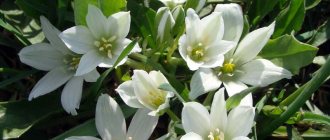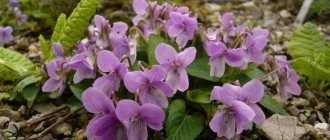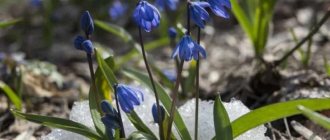Iberis, also called Iberian, is a herbaceous plant that is directly related to the cruciferous or cabbage family. This plant is also sometimes called variegated, wallflower or peppercorn. Such a plant can be found in natural conditions in the mountains of Southern Europe and Asia Minor, the southern part of Ukraine, the Caucasus, the lower reaches of the Don and the Crimea. This genus unites about 40 different species, and they are represented by annuals and perennials, which can be heat-loving or frost-resistant, and there are also herbaceous and semi-shrub varieties. This plant is often used to create an edge for lawns, flower beds, and also to decorate stonework and alpine slides. These flowers are suitable for cutting and are often used to create bridal bouquets.
Features of Iberis
Below we will discuss the features of Iberis evergreen, since it is the most popular in our country.
- The roots are taproots. That is why transplanting Iberis into open ground is not an easy task.
- Escape. It all depends on the species. They can be erect or creeping.
- The leaves are miniature.
- Iberis flowers are shaped like an umbrella and consist of small elements with a diameter of no more than a centimeter. Iberis blooms very profusely. Sometimes there are so many inflorescences on it that the leaves are completely covered. Color varies from white to red. Iberis perennial begins to bloom in May or late summer. Duration – 2 months. Iberis annual blooms much shorter. Flowers are fragrant in most species.
- Fruit. Who would have thought that a plant of the genus Iberis has an intricate pod-like fruit? It is oval or round, slightly flattened.
Composition with Iberis
Prices
Another question that concerns gardeners is the price of Iberis, soil and fertilizing for it. Currently, the cost varies within the following limits:
- for Iberis seeds: from 15 to 218 rubles per package. The cost largely depends on the variety;
- for double superphosphate - from 75 to 135 rubles per package of one kilogram;
- for Reasil feeding - from 100 to 250 rubles, the cost depends on the volume of the container.
Iberis can become a real decoration for a garden or a local area; it will fit well into the landscape design and make it unique
The main thing is to plant the seedlings correctly, care for them and transplant them into open ground in a timely manner.
Growing Iberis from seeds
For those planning to plant Iberis at home, growing from small seeds seems to be the best option. And that's why. Firstly, the seeds are easy to collect yourself. Secondly, they can be purchased at any flower shop at an affordable price. There is also a vegetation method, but it is more complex and requires more time.
For most species (Iberis bitter, Iberis umbelliferous, Gibraltar), growing from seeds is recommended in April. There is one simple way to prolong flowering. Seeds collected from Iberis or purchased in a store are planted 15-20 days apart. You can wait for the first seedlings to appear within a week. However, do not panic if nothing happens after 7 days. Shoots may appear in 10-14 days.
Shoots that are too dense are thinned out. The recommended distance between bushes is from 12 to 15 centimeters.
Reproduction methods
Basically, the annual umbrella iberis is propagated by seeds. However, if desired, you can also use the cutting method. The diagram looks like this:
- After flowering, shoots up to 5 cm are cut from a strong, healthy plant.
- The cuttings are dipped in a growth stimulator and planted in the ground or in a greenhouse.
- Throughout the season, water the plants from time to time until the autumn cold.
Although umbrella iberis from cuttings takes root very easily and quickly, this method is rarely practiced. In the fall, the annual plant, one way or another, dies. It is much more convenient to sow the crop in the right places in the garden with seeds. In this case, it will bloom brightly from late spring and most of the summer.
Sowing and seedlings of plants
We would like to give some recommendations to those who are planning to grow Iberis for seedlings. Recommended time: early spring. Loose soil is used. The seeds are immersed 1 mm in it and covered with a small layer of sand.
To create optimal substrate humidity, cover the container with glass and transfer it to a warm, well-lit place. Watering is moderate, only when absolutely necessary. Be sure to use a sprayer. Picking when growing for seedlings is not provided.
Growing from seeds (video)
What climate is it suitable for?
In the wild, Iberis is found mainly in the mountains of southern Europe and Asia Minor, in the Caucasus, Crimea and on the banks of the Don, so the optimal climate for it is hot or temperate. It withstands frost, but reacts poorly to sudden temperature changes and lack of snow. Accordingly, it is better to cover the plantings for the winter - if the temperatures are too low and there is too much precipitation, the plant may die. Otherwise, Iberis is quite hardy, and its cultivation does not require any special conditions.
Iberis is an excellent honey plant
Planting in open soil: questions and answers
We answer popular questions related to Iberis, its planting and care in open ground.
When to plant?
In order for the plants to take root well, planting in open soil is carried out when the frosts have passed. Usually this is mid-May. Choose a site with good access to the sun and rocky soil. Too wet soil will not work. Stagnation forms in the roots, which has a bad effect on the root system.
How is disembarkation done?
- The seedlings are removed from the container in which they grew. The procedure is performed very carefully so as not to injure the root. To do this, you can take a seedling along with a lump of earth.
- The bushes are planted in the soil at a distance of 12-15 centimeters.
- The earth is carefully compacted, the sprouts are watered.
- A little trick for those who would like to get Iberis of different colors and decide to plant a variety of varieties. Maintain a decent distance between the bushes - they can cross-pollinate.
Further propagation is possible by cuttings and division.
It is better to plant Iberis in late spring, after the last frost.
After flowering
Collecting seeds
Seeds appear in the places where there were flowers. Since flowering lasts quite a long time, seed ripening occurs constantly. In this regard, seeds can be collected at any time as soon as they are ripe. To do this, you need to tear off the pods and dry them, placing them in a warm place. Seeds extracted from such pods should be stored in a place where it is dry and cool until planting. There is no need to collect seeds, since Iberis reproduces well by self-sowing. In spring, you will see friendly shoots that will need to be thinned out.
Wintering perennial
Despite the fact that this flower is quite resistant to frost, it is still recommended to cover it, and spruce branches are perfect for this. First you will need to cut off that part of the bush that is located above the soil surface.
Subtleties of care
If we talk about perennial Iberis, planting and further care are completely simple. Even novice gardeners can cope with this task.
- Watering. Only in severe drought.
- Feeding. There is no urgent need for it. However, in order for the flowering to be lush and lush, it is fed with universal fertilizer 1-2 times per season.
- All fading flowers are promptly removed. The procedure is absolutely simple, but it promotes normal growth and development.
- When the bushes have faded, the shoots are shortened by a third. The plant immediately takes on a nice, neat appearance.
- At the age of 5 years, perennial Iberis is planted. If this is not done, all subsequent blooms will be less spectacular, and the flowers will decrease in size.
When is the best time?
Since ancient times, all gardeners in the world have been planting seedlings based on the lunar calendar. It is believed that the magnetic field of the Moon determines how well the seeds will sprout and how strong and healthy the plant will be.
Please refer to the following dates:
- January: 11, 14, 17 and 18;
- February: 7,8, 12, 14;
- March: 1, 2, 15, 16, 23, 28;
- April: only two days – 6 or 17;
- May: 8, 12, 15, 16, 17, 18.
In general, the rule is quite simple: do not plant seedlings three days before and three days after the full moon.
These days are considered unfavorable. There are several more dates on which it is better to refuse to plant Iberis seedlings:
- January: 3, 9, 10, 11, 17, 24, 25, 26;
- February: 2, 8, 9, 10, 16, 22, 23, 24, 25;
- March: 2, 8, 9, 10, 16, 23, 24, 25;
- April: 1, 7, 8, 9, 15, 22, 23, 24, 30;
- May: 6, 7, 8, 14, 21, 22, 23, 30.
But the lunar calendar is only one criterion for planting. Another important one is the climatic region. Let's talk about this in more detail.
Common diseases and pests
Let's start with the pests that pose a danger to Iberis. Ground fleas feed on leaf blades - they eat large holes in them. Mealyworms and aphids settle on the flowers, and you shouldn’t expect anything good from them either. Potassium soap is considered a good way to combat aphids. 200 g of the substance is dissolved in 5-6 liters of water. The resulting solution is used to treat infected flowers. Seven days later the procedure is repeated.
How to get rid of mealybugs that have taken a fancy to Iberis evergreen? The bushes are treated with fitoverm and mospilan. After 7 days, it is recommended to repeat the procedure to consolidate the result.
Fungus is another common scourge of the genus Iberis. The easiest way to prevent the problem is to try to cure plants already affected by the fungus. Before planting, a plot of land is treated with fungicides. Have the roots started to rot yet? Affected specimens are dug up and burned, and the growth site is carefully treated.
This plant does not have many pests, so with proper care, Iberis will not create problems for you.
Possible problems when growing a flower
As already mentioned, Iberis loves a warm, illuminated place and well-drained soil. If the plant does not like the conditions or care, then various problems appear, which include:
- fungal diseases;
- pests, in particular mealybug and cruciferous flea beetle;
- diseases of the root system: due to the abundance of moisture, it begins to rot;
- diseases of buds and foliage.
Mealybug - white coating on shoots.
Treated with garlic infusion, Mospilan, Aktara. Solving these problems is not difficult. It is enough to promptly remove or treat infected plants, replant healthy ones in a new place, and also treat the soil with special solutions.
Popular varieties
Among annuals, only two species are in demand: Iberis amara (bitter), Iberis umbellata (umbrella). We will talk about them.
Umbrella view
The luxurious appearance of the annual is the main reason for its popularity among gardeners. Reaches 40 cm in height. The shoots are smooth, branched, the leaves are lanceolate. The flowers have an unsurpassed aroma and color varies from white to purple. Within ten weeks the first flowers appear. Iberis umbelliferum has been cultivated since the 16th century. 2 varieties deserve special attention:
- Red Flash. Reach 30 centimeters. The flowers are bright red.
- Fairy Mixture. The height does not exceed 25 cm. A successful mixture of pastel colors.
Variety Iberis Fairy Mixture
Bitter view
Relatively low annual - only 30 centimeters. The flowers reach 2 cm in diameter and can be painted exclusively white, slightly lilac. The leaf blades are oblanceolate, the edge is serrated.
Iberis bitter
Among the common varieties are:
- Tom Thumb. Up to 15 centimeters, white flowers.
- Hyacintenblütige Riesen. 35 centimeters, lilac shade.
- Weiss Risen. 30 centimeters, white flowers.
Gardeners successfully cultivate perennials. Let's look at them in more detail.
Iberis gibraltarica – Gibraltar perennial
It can be distinguished from other varieties by its many small pink flowers. Iberis Gibraltar is semi-evergreen, diameter 40 centimeters, height 25 centimeters. Please note that Gibraltar Candytaft flowers are lilac, but turn white over time.
Gibraltar Iberis
Iberis simplex - Crimean Iberis
The bushes are very small, no more than ten centimeters. The leaves are spatulate in shape. It is noteworthy that the buds are purple in color, but when opened, the flowers are always white.
Crimean Iberis
Iberis saxatilis - rocky iberis
Reaches 15 centimeters. When flowering, a unique effect is created, as if the petals are dusted with snow.
Rocky Iberis
Iberis sempervirens - evergreen iberis
Perhaps the most popular perennial. Height 40 centimeters, leaves elongated by 7 centimeters. They have a characteristic dark green color, the diameter of the inflorescence is 5 cm. It blooms for 3 weeks very lushly and brightly, repeated flowering is possible. It first began to be cultivated in the 17th century.
Evergreen Iberis
Iberis evergreen has several varieties, among which are very popular:
- Dana. 15 centimeters bush, abundant flowering.
- Findall. 20 centimeters high, very large in diameter.
- Zwergschneeflock. Usually it can be seen on rocky masonry, the height of the bushes is 15 centimeters.
1.Description - what it looks like
Iberis or Iberian is a perennial evergreen herbaceous plant or subshrub with woody, branched shoots at the base. Annual species of Iberis are rare. Plants have thin, branched, superficially located rhizomes.
Different species can have either erect or lodging branches. When in contact with the ground, the shoots take root easily.
The leaves are dark green, spatulate, arranged alternately, reaching a length of 2 - 3 cm. The edges of the leaf blades have large denticles, the surface of the leaves is glossy.
During the flowering period, plants form round inflorescences - apical umbrellas with attractive white, pink or lilac buds up to 1.5 cm in diameter. The flowers are fragrant, open gradually, from the edge of the inflorescences to their middle, lengthening the flowering period.
The asymmetrical shape of the flowers is interesting - they have 4 oblong petals, and the outer petals are 2 - 3 times larger in size than the inner ones. In some plants, flowers can change their color as they bloom - for example, from greenish to white and pink.
After flowering, seed pods are formed, which become dry and brown when ripe. The seeds are large, oblong, dark brown, glossy.
↑ Up,
When grown in the garden, the abundant and long-lasting flowering of Iberis attracts many beneficial insects - pollinators, including butterflies and bees.
The genus includes about 40 species of attractive flowering plants. Flower growers have been attracted to this genus for a long time - the first plants began to be grown in European gardens back in the 17th century.
There are several “folk” names for the plant - for example, wallflower, peppercorn or polypetal.
↑ Up,
Dimensions . Depending on the type, plant height can reach from 20 cm to 50 cm.
Results
The light charm of fragrant iberis inflorescences will be a successful addition to any landscape. Plants feel great in our climate zone and are easy to care for. If you plant peppercorns along the edges of the border, they will shine with new colors and will look very extraordinary. The delicate palette of the cabbage plant goes well with any crops, so in rock gardens and rocky hills, a representative of the cabbage genus will definitely take its place. A particularly successful ensemble will be obtained in combination with large-flowered bells, low-growing marigolds, and phlox. And with neighbors such as cypress and dwarf pine, Iberis will always live peacefully and amicably.
Application in landscape design
Iberis can become a true decoration of any garden or summer cottage. But it is important to locate the plant in the right and correct place. The shrub will grow best in places protected from the wind.
This plant looks great in places such as:
- rock gardens;
- rocky gardens;
- edges of work;
- as a living border or flower wall;
- decorating crevices in walls or tiles.
In addition, it grows wonderfully in pots or containers. And also on terraces and balconies. Iberis can also be grown in flower beds. Especially when combined with taller flowers or plants. This will create a natural contrast that will certainly liven up the area.
If we talk about combinations with other flowers, then these could be tulips or irises. In addition, the shrub looks very advantageous in the company of roses.











